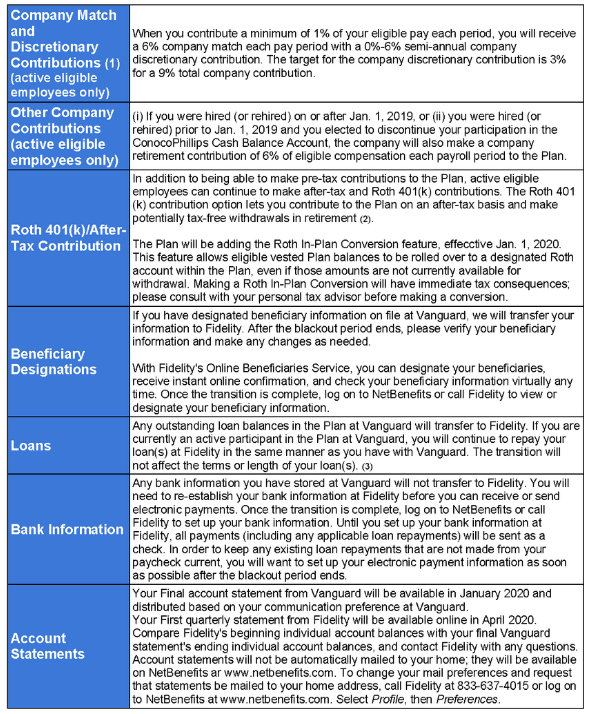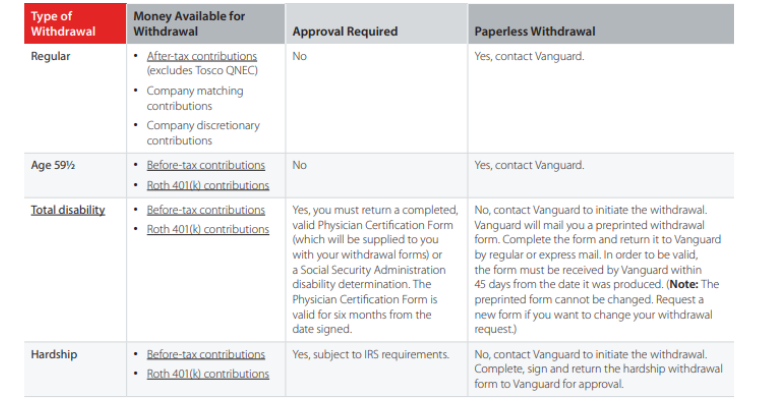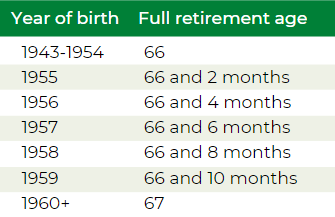Retirement Guide for ConocoPhillips Employees
2025 Tax Rates, Health Care Updates, Interest Rates, Pension Plan, and more...
In this comprehensive retirement guide for ConocoPhillips employees, we cover the most critical factors you need to take into account when considering your retirement from ConocoPhillips. These factors include healthcare & benefit changes, interest rates, 2025 tax rates, inflation, and much more.
Please note that The Retirement Group is not affiliated with ConocoPhillips. We recommend reaching out to your Corporate benefits department for further information.
Table of Contents
Section 1: 2025 Tax Changes & Inflation
Section 1.1: Tax Code Changes 2025
Section 1.2: Optimizing Retirement Contributions
Section 1.3: Dealing with Inflation
Section 2: Planning Your Retirement Section 2.1: Working with an Advisor
Section 2.2: Why Start Early?
Section 2.3: 401(k) Matching Contributions
Section 3: The ConocoPhillips Pension Plan, Explained Section 3.1: Move to Fidelity
Section 3.2: Pension Plans Overview
Section 3.3: Pension Distribution Options
Section 4: The ConocoPhillips 401(k) Plan Section 4.1: Getting Help with your 401(k)
Section 4.2: ConocoPhillips 401(k) Plan Details
Section 4.3: Withdrawal Strategies
Section 5: Healthcare and Retirement Benefits at ConocoPhillips Section 5.1: Annual Enrollment
Section 5.2: Life Insurance Details
Section 5.3: Using an HSA
Section 6: Social Security & Medicare for ConocoPhillips Employees Section 6.1: Social Security Strategy
Section 6.2: ConocoPhillips Medicare Coverage for Retirees
Section 7: Dealing with Divorce Section 7.1: Divorce and Retirement Benefits Explained
Section 7.2: Social Security Survivor Benefits
Section 8: The ConocoPhillips Survivor Checklist Section 8.1: In the event of your death
Section 8.2: If you have a joint pension
Section 8.3: ConocoPhillips medical coverage
Section 9: Life After Your Career Section 9.1: Financial benefits of working in retirement
Section 9.2: Emotional benefits of working in retirement

2025 Tax Changes & Inflation

Individuals in the United States, especially those during their working years, as well as those in their retirement years must be aware of changes and updates made by the IRS. For employees of ConocoPhillips, the most important factors for 2025 include the following:
- Standard deduction. In 2025, the standard deduction increased to $15,000 for single filers and married filing separately; $30,000 for joint filers, and $22,500 for heads of household.
- Additional deduction. Taxpayers who are over the age of 65 or blind can add an additional $1,600 to their standard deduction. A married couple filing MFJ would claim a total of $3,200 as the additional deduction. This amount jumps to $2,000 if they file single or head of household.
- Cash contributions to charity. The special deduction that allowed non-itemizers to deduct up to $300 in cash donations to charity — or $600 for those married filing jointly — has expired.
Other notable changes for tax year 2025 include the following:
- Alternative minimum tax exemption amounts: For 2025, the exemption amount for unmarried individuals increases to $88,100 ($68,650 for married individuals filing separately) and begins to phase out at $626,350. For married couples filing jointly, the exemption amount increases to $137,000 and begins to phase out at $1,252,700.
- Qualified transportation fringe benefit: For 2025, the monthly limitation for the qualified transportation fringe benefit and the monthly limitation for qualified parking rises to $325 per month, increasing from $315 per month in 2024.
- Health flexible spending cafeteria plans: For the taxable years beginning in 2025, the dollar limitation for employee salary reductions for contributions to health flexible spending arrangements rises to $3,300, increasing from $3,200 in 2024. For cafeteria plans that permit the carryover of unused amounts, the maximum carryover amount rises to $660, increasing from $640 in 2024.
- Medical savings accounts: For 2025, participants who have self-only coverage, the plan must have an annual deductible that is not less than $2,850 (a $50 increase from the previous tax year), but not more than $4,300 (an increase of $150 from the previous tax year). The maximum out-of-pocket expense amount rises to $5,700, increasing from $5,550 in 2024. For family coverage in 2025, the annual deductible is not less than $5,700, increasing from $5,550 in 2024; however, the deductible cannot be more than $8,550, an increase of $200 versus the limit for 2024. For family coverage, the out-of-pocket expense limit is $10,500 for 2025, rising from $10,200 in 2024.
- Foreign earned income exclusion: For 2025, the foreign earned income exclusion increases to $130,000, from $126,500 in 2024.
- Estate tax credits: Estates of decedents who die during 2025 have a basic exclusion amount of $13,990,000, increased from $13,610,000 for estates of decedents who died in 2024.
- Annual exclusion for gifts: This increases to $19,000 for calendar year 2025, rising from $18,000 for calendar year 2024.
- Adoption credits: For 2025, the maximum credit allowed for an adoption of a child with special needs is the amount of qualified adoption expenses up to $17,280, increased from $16,810 for 2024.
Avoiding Double-Taxation for ConocoPhillips Remote Employees
Remote workers employed by ConocoPhillips might face double taxation on state taxes. Here's what you need to know.
Thanks to the advent of remote work during and after the COVID-19 pandemic, many employees moved away from core cities. Notably, these movements could have taken them outside the state where they were employed. Some states established temporary relief provisions to avoid double taxation of income, but many of those provisions may have expired. There are only six states that currently have a "special convenience of employer" rule: Connecticut, Delaware, Nebraska, New Jersey, New York, and Pennsylvania. If you work remotely for ConocoPhillips, and if you don't currently reside in those states, consult with your tax advisor to determine if there are other ways to mitigate the double taxation.
Child Tax Credit Updates for 2025
Many of our clients who are interested in reducing their tax burdens as much as possible are excited to learn about the Child Tax Credit. Although it only applies to individuals with children under the age of 18, it can be relevant to those who are approaching retirement if they have minor children — or if their children have children!
Here are the 2025 updates:
- Maximum credit per qualifying child: $2,000 for children 5 and under; $3,000 for children 6 through 17.
- Child Tax Credit eligibility. As a parent or guardian, you are eligible for the Child Tax Credit if your adjusted gross income is less than $200,000, or $400,000 married filing jointly.
- Partial refundability. If your Child Tax Credit is greater than your tax, you can receive up to $1,600 as a cash refund.

How ConocoPhillips employees can optimize their retirement contributions
Contributing to your company's 401(k) plan can cut this year's tax bill significantly.
With the right planning, these benefits can be compounded over time. In 2025, the amount you can save increased:
- 2025 limit. Individuals can contribute $23,500 to their 401(k) plans in 2024.
- Catch-up contributions. Employees age 50 and over can contribute an extra $7,500, bringing their total limit to $31,000. For those turning 60 - 63 years of age during calendar year 2025, their catch-up provision is $11,250 for a combined total of $34,750.
- A major opportunity. Lowering your taxable income by up to $34,750 means less of your money is immediately taxed. As displayed by the table below, this could save you thousands on your current tax bill.
Many investors choose to invest the money that they save in taxes this year. This bonus nest egg then has the opportunity to grow in the market, which can help pay the deferred tax when they make withdrawals from their accounts later in life.

Dealing with Inflation
Inflation — we're all too familiar with it. Inflation degrades purchasing power over time, meaning the same things cost more year after year. While inflation is difficult to deal with as a working adult, managing it becomes more dire in retirement.
In order to maintain the same standard of living in retirement, you need to factor rising costs into your plan. While the Federal Reserve targets 2% inflation each year, the scorching inflation of the early 2020s reminded us that Fed targets are anything but a guarantee.
When nearing retirement, it's important to keep track of the rate of inflation, especially in specific areas like healthcare. While prices as a whole have risen dramatically, increases in particular categories can outpace inflation, which can lead to unpleasant surprises down the road if you're not prepared. Speak with a qualified financial advisor when constructing your holistic plan to help plan for the impacts of future inflation.
*Source: IRS.gov, Yahoo, Bankrate, Forbes
Planning Your Retirement from ConocoPhillips

Retirement might seem like something too far away — or too complicated — to worry about today.
The reality is that the longer you wait to plan, the more opportunities you miss.
No matter where you stand in the planning process, or your current age, we designed this guide to provide you with a comprehensive overview of the steps to take toward retirement. With the right resources, you can simplify and streamline your transition from ConocoPhillips into retirement — and get the most of your benefits in the United States.
You know you need to be saving and investing, because "time in the market" beats "timing the market". But even if you've been investing for years, the game changes entirely once you switch from saving to spending.
That's where The Retirement Group comes in. We've partnered with Wealth Enhancement to offer a wide range of retirement planning resources. With a qualified, competent, and caring advising team by your side, ConocoPhillips employees in the United States can make the most of what they've saved, and better plan for what they still need.
"A separate study by Russell Investments, a large money management firm, came to a similar conclusion. Russell estimates a good financial advisor can increase investor returns by 3.75 percent."
There's a 79% potential boost in wealth at age 65 over a 20-year period when choosing to invest in your company's retirement plan.
*Source: Bridging the Gap Between 401(k) Sponsors and Participants, T.Rowe Price, 2020
As decades go by, you’re likely full swing into your career at ConocoPhillips, and your income reflects that. However, the challenges of saving for retirement start coming from large competing expenses: a mortgage, raising children, saving for college, and more...
One of the classic planning conflicts is saving for retirement versus saving for college. Most financial planners will tell you that retiring in your 60s from your company should be your top priority because your child can usually find support from financial aid — while you may need to fund more of your retirement yourself.
Source: Is it Worth the Money to Hire a Financial Advisor?, The Balance 2021
Why start investing early?
Starting to save as early as possible matters. Time on your side means compounding can have significant impacts on your future savings. Once you’ve started, continuing to increase and maximize your contributions for your retirement plan is key.

Waiting to invest in your retirement accounts can cost you. This hypothetical illustration shows the potential risks of waiting just 10 years to start investing in an IRA.
Assuming a $100 monthly investment and an annual return of 8%, an investor who starts at age 25 instead of age 35 would have an extra $200,000 in their account when they reach age 65. This example certainly underscores the importance of starting early, but it also illustrates the importance of repeated, continuous investment. $100 a month might not seem like a lot to start out with, but by sticking with it, both of the investors in our example amassed a significant nest egg that will be able to support them in retirement.
Of course, how much we recommend that you invest towards your retirement is always based on your unique financial situation and goals. However, consider investing a minimum of 10% of your salary toward retirement through your 30s and 40s. So long as your individual circumstances allow, it should be a goal to maximize your contribution.
Why are 401(k)s and matching contributions so popular?
401(k)s are powerful tools for your retirement savings plan. They provide three main opportunities:
- Compound growth opportunities (as evidenced by the example above)
- Tax saving opportunities
- Matching contributions
Matching contributions are just what they sound like: Your company matches your own personal 401(k) contributions up to some point, using money that comes from the company. Typically, if your employer offers a match, they will match up to a certain percent of the amount that you invest.
For example, let's say ConocoPhillips offers you a 5% match to your 401(k) investments. If your salary is $100,000 and you invest $5,000 in your 401(k), ConocoPhillips would then match that amount, also investing $5,000 in your 401(k) — resulting in a $10,000 increase to your 401(k) balance. If you invested $10,000 instead, ConocoPhillips would match $5,000 of that amount, bringing your total annual 401(k) investment to $15,000 for that year.
A 2020 study from Financial Engines titled “Missing Out: How Much Employer 401(k) Matching Contributions Do Employees Leave on the Table?”, revealed that employees who don’t maximize their company match typically leave $1,336 of extra retirement money on the table each year. That amount of money could make a serious difference to your retirement portfolio.

The ConocoPhillips Pension Plan, Explained
There are early-out offers, interest rate impacts, age penalties, and complex tax implications — not to mention the seemingly endless rules that vary from one pension option to the next.
Increasing your investment balance and reducing taxes is the key to a successful retirement plan spending strategy. At The Retirement Group, we can help you understand how ConocoPhillips' Pension Plan fits into your overall financial picture and how to make that plan work for you.
ConocoPhillips employees in your state who are in their 50s and 60s may be able to gain a significant advantage by properly understanding their pension plan. In this section, we'll give you the tools to do just that.
Need Advice? Work with Experienced Advisors
Financial advisors at The Retirement Group have extensive experience helping ConocoPhillips employees and retirees in the United States make decisions in regard to the following plans, and more:
- ConocoPhillips Savings Plan (CPSP) ConocoPhillips Pension Plan (CPPP)
- Phillips 66 Savings Plan (P66SP)
- Phillips 66 Pension Plan (P66PP)
- VCIP Restricted Share Units (RSUs) Performance Share Program (PSP)
- Key Employee Supplemental Retirement Plan (KESRP)
- Key Employee Deferred Compensation Plan (KEDCP)
- Targeted Variable Long Term Incentive Plan (TVLTI)
In this section, we will next cover the basics of the most common ConocoPhillips Pension Plans (Title I, Title II, and Title IV).
Move to Fidelity: Your Investing Options Don't Change
Overview
As the blackout period has ended, you will have access to your plan information via Fidelity NetBenefits®.

ConocoPhillips Pension Plans Overview
There are 8 different pension plans at ConocoPhillips, which are referred to as "Titles". Most employees fall under Title I, Title II, or Title IV. If you don't fall under one of these plans or aren't sure which plan you fall under, please reach out to one of our financial advisors for further guidance.
First, we will explore the details of Title I.
Title I: Phillips Retirement Income Plan (PRIP)
This pension plan impacts most heritage Phillips employees and is a Defined Benefit pension plan, calculated using your Final Average Earnings with the company, your total service, and a Social Security Offset.
By the plan's definition, the normal retirement age is 65. However, it is possible to receive an unreduced benefit as early as age 60. Although there is no early retirement reduction, there is an actuarial reduction. As with all the pension plans, the PRIP may be taken as a Lump Sum, a Single Life Annuity, or a Joint Survivor Annuity with various survivorship options. We'll go over these options in greater detail later.
The PRIP cannot be commenced until age 55. You may also encounter age penalties, which are about 5% per year prior to age 60, if you work until at least 55. These penalties can be even more costly if you leave the company prior to age 55.
If you are considering a lump-sum on this pension plan, it is very important to pay attention to interest rates as you approach retirement. Interest rates on this plan change quarterly and have a negative correlation with the lump-sum payout. Explained another way, rising interest rates will typically reduce the value of your lump-sum. The interest rates that are used in this calculation are the Corporate Bond Segment Rates as well as the GATT rate (30-year Treasury), which impact different segments of your career. ConocoPhillips will use the average interest rates of the fourth month prior to the quarter you commence your benefit, which can be helpful in timing the election of your benefit to maximize the lump-sum payout.
How to Calculate Your Monthly Benefit under the PRIP
Final Average Earnings (FAE) = The monthly average of your highest 3 consecutive years of annual earnings out of the last 11 calendar years.
Credited Service (CS) = The number of months you have been participating in the Title I plan. Limited to 576 credits in Final Average Earnings Subtotal; limited to 400 credits in Social Security Offset.
Primary Social Security (PSS) = The estimated monthly Social Security benefit that you would receive at your normal retirement age.

Alternative Formula under the PRIP
As an alternative to the Final Average Earnings Monthly Benefit, you may receive the Minimum Retirement Income Benefit. This benefit is calculated using the following formula:
Credited Service (CS) = The number of months you have been participating in the Title I plan. Limited to 576 credits.
$15 x CS = Annual Minimum Retirement Income Benefit
Annual Minimum Retirement Income Benefit / 12 = Monthly Minimum Retirement Income Benefit
Remember: Companies make mistakes!
- If the company over-projects your offset: Send in your social security statement to correct. This can lead to a larger annuity/lump-sum benefit.
- If the company under-projects your offset: You get to keep the larger benefit.
- Be careful sending in your statement without first consulting a TRG advisor. It could have significant implications on your retirement.

Title II: ConocoPhillips Cash Balance Plan (CBP)
This pension plan is considered a Defined Contribution pension plan and was originally offered after the merger between Conoco Inc. and Phillips Petroleum Co. This is the pension plan offered to most new hires and was also offered to existing employees after the merger who wanted to switch over from their heritage pension plans. As with all the pension plans, the CBP may be taken as a Lump Sum, a Single Life Annuity, or a Joint Survivor Annuity with various survivorship options.
The CBP is credited monthly by ConocoPhillips with both interest credits and pay credits. The Interest Credits are based on 30-year Treasury rates and the Pay Credits are based on total age and service points as follows:
Age Points + Service Points = Number of points under...
- 44 points = 6% pay credit percentage
- 44 through 65 points = 7% pay credit percentage
- 66 or more points = 9% pay credit percentage
Unlike the Defined Benefit pension plans, the CBP lump-sum does not fluctuate quarterly based on changing interest rates. In fact, it is actually a benefit to this plan when interest rates rise, as the plan will receive higher interest credits. The annuity options on this pension, however, may be affected by changing interest rates, so we recommend paying attention to them if you are considering one of the annuity options on this pension.
How to calculate Your Monthly Credits with the COP Cash Balance Plan
Eligible Monthly Pay = Annual earnings ÷ 12
Pay Credit % = See table on previous page
Monthly Interest Credit Rate = 30 Year U.S. Treasury Rate from 4 months before quarter of retirement (no less than 0.99%)

COP Cash Balance Plan Changes
The COP Cash Balance Plan was closed 1/1/19 for new hires and moved to the 401(k), making it like a Money Purchase Pension Plan within the 401(k). If you were a participant, you could either keep the CB Plan or move to the new plan. The new plan keeps the same 6%, 7%, 9% contributions metrics. So total COP contributions now range from 12% - 18% (15% goal) for newer employees, and 15% - 21% (18% goal) for older employees. Credits are based on points by combining age and service.
- Under 44 = 6%
- 44 – 65 = 7%
- 66+ = 9%
The 401(k) still has the 6% match and the 0%-6% discretionary with the goal of 3% for a target of 9% total.
There are pros and cons to the Cash Balance Plan being moved to the 401(k):
Pro – You now have full control of the funds for investment purposes and they are not tied to low treasury rates.
Con – If you are highly compensated or want to max your 401(k), it reduces the amount based on the $57,000 total contributions cap. Previously, the Cash Balance Plan was under pension rules and not part of the cap. Example: For someone who is making $150,000 and has more than 66 points, the 9% or $13,500 that used to go into the CB plan now goes into the 401(k) and reduces the amount they can contribute by that much. That same person would have a target of 18% or $27,000 going in from COP. Assuming they are over age 50, the max total is $63,500 leaving $36,500 or 24.33% eligible for contributions. If they made $200,000 it leaves $27,500 or 13.75% for contributions and costs them $18,000 in contributions that used to be in the CB Pension Plan. Hopefully they elected to remain in the plan and not move to the new plan!
If you have further questions about the Title II plan, please don't hesitate to reach out.

Title IV: Retirement Plan of Conoco (RPC)
This pension plan impacts most heritage Conoco employees and, like the PRIP, is a Defined Benefit pension plan, calculated using your Final Average Earnings with the company (High 3 Formula), your total service, and a Social Security Offset. The normal retirement age is 65, but qualifying employees become eligible once they are 50 years old with at least 10 years of service. As with all the pension plans, the CBP may be taken as a Lump Sum, a Single Life Annuity, or a Joint Survivor Annuity with various survivorship options.
Although age 50 is the earliest you may begin your pension benefit under the RPC, it is possible to receive a pension benefit without making it to the 50 plus 10 milestone. However, benefits are substantially reduced, as age penalties for a normal retirement are about 4% per year prior to age 60.
If you are considering a lump-sum on this pension plan, it is very important to pay attention to interest rates as you approach retirement. Interest rates on this plan change quarterly and have a negative correlation with the lump-sum payout (as in, rising interest rates will typically reduce the value of your lump-sum). The interest rates that are used in this calculation are the Corporate Bond Segment Rates, the GATT rate (30-year Treasury), and the PBGC rate, all of which impact different segments of your career. ConocoPhillips will use the average interest rates of the fourth month prior to the quarter you commence your benefit, which can be helpful in timing the election of your benefit to maximize the lump sum payout.
How to Calculate Your Monthly Benefit Under the Retirement Plan of Conoco
There are 3 formula options for this plan, but usually the High 3 Formula yields the highest benefit.
High 3 Formula:
Annual average of highest compensation over 3 consecutive years (or 36 months) x Years of Creditable Service x (1.6%/12) = 3 Year Average Compensation calculation.
Primary Social Security Benefit x Years of Creditable Service x 1.5% = Social Security Offset.
3 Year Average Compensation calculation - Social Security Offset = Monthly Benefit under High 3 Formula.
High 10 Formula (Only applies to employees who joined Title IV plan before 1971):
- Annual average of highest compensation over 10 consecutive years - $3,000 = Excess compensation
- Excess compensation x 1.5% = Excess benefit
- Excess benefit + $30 = Preliminary benefit
- Preliminary benefit x Years of Creditable Service = Annual Benefit under High 10 Formula
- Annual Benefit under High 10 Formula ÷ 12 = Monthly Benefit under High 10 Formula
Minimum Benefit Formula:
Years of Service x $12 = Initial Benefit
Initial Benefit - result of either High 3 or High 10 calculation (whichever is higher) over period in which employee was eligible but did not participate in Title IV plan = Monthly Benefit under Minimum Formula
Remember, companies make mistakes!
- If the company over-projects your offset: Send in your social security statement and correct the mistake. This can lead to a larger annuity/lump-sum benefit.
- If the company under-projects your offset: You get to keep the larger benefit.
- Be careful sending in your statement without first consulting a TRG advisor.

Where to Find Information About Your ConocoPhillips Pension Benefit
NetBenefits is a website that contains your complete personalized pension benefit information. Log on to NetBenefits at http://hr.conocophillips.com/contacts-resources/fidelity/.
Deciding to start your ConocoPhillips pension benefits is an important milestone that involves specific mandatory actions. The process requires you to be on top of every action step and deadline along the way. As you start your retirement process, be sure to pay close attention to the steps you have to take and the specific deadlines for each one.
This guide will help you stay on track throughout the process. To get started:
- Get familiar with a few key terms related to the retirement process.
- Review the overall process timeline.
- Learn all you can by using the resources available to you.
- Understand how your actions will impact the timing of your pension payment.
- Get started on your retirement process to-do list.
ConocoPhillips Retirement Timeline
60-90 days before you want your pension benefits to begin:
- Establish your employment end date with your supervisor and notify your HRBP.
- Request your pension paperwork and confirm what other benefits you are eligible for through Fidelity NetBenefits or call the Retirement Center at 833-637-4015.
- If you and/or your spouse are eligible for Medicare on your employment end date, contact the Benefits Center at 800-622-5501 to avoid a gap in medical coverage.
30-60 days before you want your pension benefits to begin
- Elect your form of pension payment on Fidelity NetBenefits or call the Retirement Center at 833-637-4015.
- Return required retirement forms.
After your employment end date
- If eligible, enroll in retiree medical and/or life insurance on My Benefits within 30 days or any COBRA coverage within 65 days. You may also call the Benefits Center at 800-622-5501.
- Receive your pension payment approximately four to six weeks after your benefit calculation has been finalized.
- Consider when you’d like to take a distribution from your ConocoPhillips Savings Plan. Contact Fidelity at 833-637-4015 or visit site.

Your Pension Paperwork — Timing Is Everything
You may have the option to choose a lump-sum benefit payment or monthly annuity payments. No matter which form of payment you choose, you must request and submit specific paperwork to receive your money. Every step of the process must be completed by each deadline. Generally, your lump-sum payment will be made four to six weeks after your benefit commencement date (BCD).
Important Information About Critical Dates in the Retirement Process:
- Request your pension paperwork about 60 to 90 days ahead of your BCD — but no later than the 15th of the month before your BCD.
- If you request your paperwork after the 15th of the month, your BCD will be delayed by a month.This date (the 15th of the month) is critical if you elect a lump-sum pension payment, as the interest rate as of your BCD is used to calculate your benefit.
- If electing a monthly annuity, the Benefits Center must receive your completed pension paperwork on or before the fifth of the month before your BCD.
If the Benefits Center receives your pension paperwork on time, you can expect your first payment around your BCD. If the Benefits Center receives your paperwork later in the process, your payment will be delayed accordingly.
ConocoPhillips Pension Distribution Options Explained

- Immediate Straight Life Annuity: Provides a fixed monthly payment for your life. No monthly payments will be made after your death.
- Total Lump-Sum Payment: A single cash payment of your vested balance. The cash payment can be rolled over to an IRA or to a qualified employer plan.
- Immediate Joint and Survivor Annuity: Provides fixed monthly payments for your life. On your death, 50%, 75% or 100% (depending on the percent you elect) of the original monthly payment will continue for the life of your joint annuitant. If you die, joint annuitant payments are payable only to the individual you name when you select this option. You may not change your joint annuitant after annuity payments begin. If you name your spouse as your joint annuitant, the annuity is payable only to that spouse—not to anyone else you may marry at a later date.
Pension Payment Options
Thinking about what to do with your pension is an important part of planning for your retirement at COP. Should you take the Lump Sum or Annuity? When should you take it? What is best for you and your family? To find out more information read our "Lump Sum vs. Annuity" e-book.
You should routinely use the tools and resources found on The Retirement Group's e-book gallery, such as the Retirekit, to model your pension benefit in retirement and the pension payment options that will be available to you.
You can also contact a COP dedicated adivsor at The Retirement Group at (800)-900-5867. We will get you in front of a COP focused advisor to help you start the retirement process and tell you about your payment.
Note: We recommend you read the COP Summary Plan Description. The Retirement Group is not affiliated with ConocoPhillips.
What's the Next Step?
Determine if you should take the COP Pension as a Lump Sum or Annuity.
Do you understand how and why interest rates affect your pension payment decision?
-
Use the "Retirekit" to understand cash flow, interest rates, and explore which pension option might be the best fit for you during retirement.
-
As you get closer to your retirement date, contact a COP focused advisor at The Retirement Group and also read the applicable SPD Summary to start your retirement process.
-
COP will need you to provide documents that show proof of birth, marriage, divorce, Social Security number, etc., for you and your spouse/legally recognized partner.
-
COP has Beneficiary Designation online to make updates to your beneficiary designations, if applicable to your pension program. Please read your SPD for more details.
Lump-Sum vs. Annuity: How to decide?
ConocoPhillips employees in your state who are eligible for a pension are often offered the choice of whether to actually take the pension payments for life or receive a lump-sum dollar amount for the “equivalent” value of the pension. The idea is that you could then take the money, roll it over to an IRA, invest it, and generate your own cash flows by taking systematic withdrawals throughout retirement from ConocoPhillips.
The upside of keeping the pension annuity is that the payments are guaranteed to continue for life (at least to the extent that the pension plan itself remains solvent and doesn’t default). Thus, whether you live 10, 20, or 30 (or more!) years after leaving ConocoPhillips, you don’t have to worry about the risk of outliving your money.
In contrast, selecting the lump-sum gives you the potential to invest, earn more growth, and potentially generate even greater retirement cash flow. Additionally, if something happens to you, any unused account balance will be available to a surviving spouse or heirs. However, if you fail to invest the funds for sufficient growth, there’s a danger that the money could run out altogether — and you may regret not having held onto the pension’s “income for life” guarantee.
Ultimately, your decision will depend on what kind of return must be generated on that lump-sum to replicate the payments of the annuity. After all, if it would only take a return of 1% to 2% on your lump-sum to create the same pension cash flows for a lifetime, there is a smaller risk that you will outlive the lump-sum after leaving ConocoPhillips, even if you withdraw from it for life. However, if the pension payments can only be replaced with a higher and much riskier rate of return, there is, in turn, a greater risk those returns won’t manifest and you could run out of money.
Interest Rates and Life Expectancy
In many defined benefit plans, like the COP pension plan, current and future retirees are offered a lump-sum payout or a monthly pension benefit. Sometimes these plans have billions of dollars worth of unfunded pension liabilities, and in order to get the liability off the books, the company offers a lump-sum.
Depending on life expectancy, the initial lump-sum is typically less money than regular pension payments over a normal retirement timeframe. However, most individuals that opt for the lump-sum plan to invest the majority of the proceeds, as most of the funds aren't needed immediately after retirement.
Something else to keep in mind is that current interest rates, as well as your life expectancy at retirement, have an impact on annuity payout options of defined benefit pension plans. Lump sum payouts are typically higher in a low interest rate environment. Lump sums decrease in a rising interest rate environment.
Additionally, projected pension lump sum benefits for active employees will often decrease as an employee ages and their life expectancy decreases. This is can potentially be a detriment of continuing to work, so it is important that you run your pension numbers often and thoroughly understand the timing issues. Other factors such as income requirements, need for survivor benefits, and tax liabilities often dictate the decision to take the lump-sum over the annuity option on the pension.

Interest Rates and your Pension Decision
Should you desire to take your pension as a lump sum, ConocoPhillips will use interest rates and your age to calculate your lump sum payment. When interest rates move up or down, your pension lump sum amount will move in an inverse relationship (except for the Cash Balance Pension Lump Sum payouts). This means that a rising interest rate will result in a lower lump sum payment and vice versa.
On average, a 1% increase in interest rates results in roughly an 8%-12% decrease to your pension lump sum (varies by age). Conversely, a 1% decrease to interest rates results in roughly an 8%-12% increase in your lump sum pension value.
Given the current complex interest rate environment, we strongly suggest discussing your options with The Retirement Group. We monitor rates on a daily basis and keep you updated on the monthly changes. We can provide a complimentary Cash Flow Analysis to show you how various retirement dates may play out.
It is important to remember that the annuity may be a better fit no matter how attractive the lump sum may be. Every situation is unique, and a Cash Flow Analysis will allow you to compare all pension options.
The ConocoPhillips 401(k) Plan

When is the last time you reviewed your company's 401(k) plan account or made any changes to it?
If it’s been a while, you’re not alone. 73% of plan participants spend less than five hours researching their 401(k) investment choices each year, and when it comes to making account changes, the story is even worse.
When you retire from ConocoPhillips, if you have balances in your 401(k) plan, you will receive a Participant Distribution Notice in the mail. This notice will show the current value that you are eligible to receive from each plan and explain your distribution options. It will also tell you what you need to do to receive your final distribution. Please call The Retirement Group at (800)-900-5867 for more information and we can help you get in front of a specific retirement-focused advisor.
Next Step:
- Watch for your Participant Distribution Notice and Special Tax Notice Regarding Plan Payments. These notices will help explain your options and what the federal tax implications may be for your vested account balance.
- "What has Worked in Investing" & "8 Tenets when picking a Mutual Fund".
- To learn about your distribution options, call The Retirement Group at (800)-900-5867. Click our e-book for more information on "Rollover Strategies for 401(k)s". Use the Online Beneficiary Designation to make updates to your beneficiary designations, if needed.
Note: If you voluntarily terminate your employment from ConocoPhillips, you may not be eligible to receive the annual contribution.
Getting help with your 401(k)
Over half of plan participants in the United States admit they don’t have the time, interest, or knowledge needed to manage their 401(k) portfolio. But the benefits of getting help go beyond convenience.

A Charles Schwab study found several positive outcomes common to those using independent professional advice. They include:
- Improved savings rates – 70% of participants who used 401(k) advice increased their contributions.
- Increased diversification – Participants who managed their own portfolios invested in an average of just under four asset classes, while participants in advice-based portfolios invested in a minimum of eight asset classes.
- Increased likelihood of staying the course – Getting advice increased the chances of participants staying true to their investment objectives, making them less reactive during volatile market conditions and more likely to remain in their original 401(k) investments during a downturn. Don’t try to do it alone.
Get help with your company's 401(k) plan investments. Your nest egg will thank you.

ConocoPhillips 401(k) Plan Details
Next, let's dive into the details of the ConocoPhillips 401(k) plan. We'll cover eligibility, contributions, company matching, vesting schedules, breaks in service, loans, and withdrawals.
ConocoPhillips 401(k) Plan Eligibility
You are eligible to participate in the plan if you are an active employee on the direct U.S. dollar payroll. Contact NetBenefits to enroll in the plan at any time following your date of hire.
Contributions to the Plan
The plan consists of your voluntary contributions and company matching, discretionary, and retirement contributions.
Company Matching and Discretionary Contributions
When you contribute 1% of eligible pay, you will receive a 6% company matching contribution. You must contribute at least 1% each pay period to receive the company match for each pay period.
ConocoPhillips may make an additional 0% – 6% discretionary contribution. The target for the discretionary contribution is 3%, for a 9% total company contribution (match + discretionary). The discretionary contribution of 0% – 6% will be based on factors such as company performance and market conditions. It will be reviewed twice a year for the January – June and July – December periods (each an award period) and deposited as a lump sum into your account in the same investment options that you have selected for your voluntary contributions to the plan.
ConocoPhillips Company Retirement Contributions
Vesting
Vesting refers to your right to ownership in your account balance. You are always 100% vested in your voluntary contributions, company matching, and company discretionary contributions.
After three years of service with ConocoPhillips, or when you reach age 65 or age 55 with at least five years of service, you are 100% vested in any company retirement contributions.
Break in Service
If you terminate your employment before you are vested in company retirement contributions and later return, you may have what is called a break in service. This occurs when you fail to return to employment within a 12-month period. If the number of break in service years between when you terminated employment and your rehire is five years or greater, you may be required to restart the three-year vesting period for company retirement contributions.
Loans
You may be eligible to apply for a loan from the plan if:
- You are an active employee; and
- You have an account balance of $2,000 or more.
The maximum amount allowed by federal law is the lesser of:
- $50,000, minus the sum of all your highest outstanding loan balances during the one-year period ending on the valuation date before the date the loan is issued. For this purpose, all loans from all employer plans are aggregated; and
- 50% of your account balance (excluding company retirement contributions) in this plan, minus the sum of all your outstanding loan balances from all employer plans as determined on the valuation date immediately before the date upon which the loan proceeds are distributed.
Withdrawals

Net Unrealized Appreciation (NUA)
When you qualify for a distribution from your 401(k) plan, you have three options:
- Roll-over your qualified plan to an IRA and continue deferring taxes.
Take a distribution and pay ordinary income tax on the full amount.
Take advantage of NUA and reap the benefits of a more favorable tax structure on gains.
So how does Net Unrealized Appreciation actually work?
First, you must be eligible for a distribution from your qualified company-sponsored plan, which typically happens at retirement age. Generally, you would take a "lump-sum" distribution from the plan, distributing all assets from the plan during a 1-year period. The portion of the plan that is made up of mutual funds and other investments can be rolled into an IRA for further tax deferral. The highly appreciated company stock is then transferred to a non-retirement account.
The tax benefit comes when you transfer the company stock from a tax-deferred account to a taxable account. At this time, you apply NUA and you incur an ordinary income tax liability on only the cost basis of your stock. The appreciated value of the stock above its basis is not taxed at the higher ordinary income tax but at the lower long-term capital gains rate, currently 15%. This could mean a potential savings of over 30%.
Example: Net Unrealized Appreciation (NUA) Tax Savings

As a ConocoPhillips employee in the United States, you may be interested in understanding NUA from a financial advisor. Reach out today to schedule a complimentary meeting.
IRA Withdrawal

Your retirement assets may consist of several retirement accounts: IRAs, 401(k)s, taxable accounts, and others.
What is the most efficient way to take your retirement income after leaving ConocoPhillips?
This problem is called withdrawal sequencing, and it's a problem we're well-equipped to deal with at The Retirement Group.
You may want to consider meeting your income needs in retirement by first drawing down taxable accounts rather than tax-deferred accounts. This may help your retirement assets with your company last longer as they continue to potentially grow tax deferred.
You will also need to plan to take the required minimum distributions (RMDs) from any company-sponsored retirement plans and traditional or rollover IRA accounts when you reach age 73.
Two flexible distribution options for your IRA
When you need to draw on your IRA for income or to take your RMDs, you have a few choices. Regardless of what you choose, IRA distributions are subject to income taxes and may be subject to penalties and other conditions if you’re under 59½.
Option 1. Partial withdrawals: Withdraw any amount from your IRA at any time. If you’re 73 or over, you’ll have to take at least enough from one or more IRAs to meet your annual RMD.
Option 2. Systematic withdrawal plans: Structure regular, automatic withdrawals from your IRA by choosing the amount and frequency to meet your income needs after retiring from ConocoPhillips. If you’re under 59½, you may be subject to a 10% early withdrawal penalty (unless your withdrawal plan meets Code Section 72(t) rules).
Your tax advisor can help you understand distribution options, determine RMD requirements, calculate RMDs, and set up a systematic withdrawal plan.
Healthcare and Retirement Benefits at ConocoPhillips

ConocoPhillips Company Benefits Annual Enrollment
Annual enrollment for ConocoPhillips' benefits usually occurs each fall.
Before it begins, you will be mailed enrollment materials and an upfront confirmation statement reflecting your benefit coverage to the address on file. You’ll find enrollment instructions and information about your benefit options from your company and contribution amounts. You will have the option to keep the benefit coverage shown on your upfront confirmation statement, or select benefit options offered by ConocoPhillips that better support your needs. You may be able to choose to enroll in eBenefits and receive this information via email instead.
ConocoPhillips Short-Term & Long-Term Disability Coverage
- Short-Term: Depending on your plan, you may have access to short-term disability (STD) benefits through ConocoPhillips.
- Long-Term: Your plan's long-term disability (LTD) benefits are designed to provide you with income if you are absent from employment for six consecutive months or longer due to an eligible illness or injury.
ConocoPhillips Life Insurance Details
Your life insurance coverage and any optional coverage you purchase for your spouse/domestic partner and/or children ends on the date your employment with your company ends, unless your employment ends due to disability. If you die within 31 days of your termination date from your company, benefits are paid to your beneficiary for your basic life insurance, as well as any additional life insurance coverage you elected.
Note:
- You may have the option to convert your life insurance to an individual policy or elect portability on any optional coverage.
- If you stop paying supplementary contributions, your coverage will end.
- If you are at least 65 and you pay for supplemental life insurance, you should receive information in the mail from the insurance company that explains your options.
- Make sure to update your beneficiaries. See ConocoPhillips SPD for more details.
ConocoPhillips Beneficiary Designations
As part of your retirement planning and estate planning, it’s important to name someone to receive the proceeds of your benefit programs in the event of your death. That’s how ConocoPhillips will know whom to send your final compensation and benefits. This can include life insurance payouts and any pension or savings balances you may have.
When you retire from ConocoPhillips, make sure that you update your beneficiaries. Your company should have an Online Beneficiary Designation form for life events such as death, marriage, divorce, child birth, adoptions, etc.
If you are unsure about your company's benefits, schedule a call to speak with one of our retirement-focused advisors.
Next Steps:
- Watch for your annual enrollment information in the September/November time frame.
- Review your benefits information and utilize the tools and resources available on the ConocoPhillips Benefits Center website
- Enroll in eBenefits
Things to keep in mind:
- 47% of Americans cite health care as their greatest economic concern.
- Medical bills are the No. 1 cause of bankruptcy in the United States.
- For older Americans, healthcare costs represent the second-largest expense, behind housing.

Using an HSA for retirement health care
Health care costs are increasing drastically. According to the Centers for Medicare & Medicaid Services, health care in 2022 accounted for over 17% of the United State's GDP — which amounted to $4.5 trillion.
This raises the question: How will you be paying for health care in retirement?
Health Savings Accounts (HSAs) are tax-advantaged accounts designed for individuals with high-deductible insurance plans. For 2025, the IRS defines high-deductible plans as those with a minimum deductible of $1,650 for individuals, or $3,300 for families.
HSAs are often celebrated for their utility in managing health care expenses in a tax-smart way, with three primary benefits:
- HSAs allow contributions to be made pre-tax.
- Investments within HSAs grow tax-free.
- Withdrawals are tax-free for qualified medical expenses.
Thanks to this triple tax advantage, HSAs are a potent retirement savings vehicle, especially after you've maxed out the employer match to your ConocoPhillips 401(k) in the United States.
HSA Contribution Limits & Retirement Strategy
In 2025, individuals can contribute $4,300 to an HSA, and families can contribute $8,550. Those aged 55 and older can contribute an additional $1,000.
When it comes to its place in your retirement toolbelt, HSAs really shine after you reach your employer's maximum match in 401(k) contributions. While 401(k)s offer tax-deductible contributions and tax-deferred growth, their withdrawals are taxable. HSAs bypass the withdrawal tax for qualified medical expenses, which are a significant (and increasing!) portion of retirement costs.
However, after age 65, the HSA flexes its muscles even more. After this age, funds can be withdrawn for any purpose, and subject to only regular income tax if used for non-medical expenses. This flexibility offers the benefits of traditional retirement accounts, but with the added advantage of tax-free withdrawals for qualified medical costs.
Further, HSAs to not have Required Minimum Distributions (RMDs) like 401(k)s and Traditional IRAs do, offering more control over tax planning in retirement. This makes HSAs particularly relevant for those who don't anticipate needing all of their funds right away in retirement — or who want to minimize their taxable income, perhaps as a part of a deferred compensation strategy.
HSA Investment Strategy Insights: Initially, conservative investment within an HSA is prudent. Early on, it's important to focus on ensuring that you have sufficient liquid funds to cover near-term deductible and out-of-pocket medical expenses. However, once you've established a solid financial cushion, treating an HSA like a retirement account by investing in a diversified mix of assets can significantly boost long-term opportunity — and flexibility.
What can an HSA cover?
In retirement, HSAs can cover a range of expenses:
- Medical expenses. You can use HSA funds tax-free for qualified medical expenses, which include most doctor visits, prescriptions, and dental or vision care.
- Medicare premiums. HSA funds can pay for Medicare Part B, Part D, and Medicare Advantage premiums.
- Long-term care. HSA funds can cover some amount of qualified long-term care insurance premiums or services.
- Non-medical expenses. After age 65, you can withdraw HSA funds for non-medical expenses without penalty, although these withdrawals will be taxed as regular income.
HSAs are a powerful retirement tool, with unique advantages that can augment your ConocoPhillips health care benefits. By making strategic contributions and considerate withdrawals, you can maximize your financial health in retirement, while also prioritizing your physical health.
Social Security & Medicare for ConocoPhillips Employees

Claiming Social Security is one thing — understanding the "why" behind your claim is something else entirely. Understanding Social Security is a difficult but crucial step towards your retirement paycheck. For many Americans, Social Security benefits are core to their retirement income strategy. However, when and why you claim them depends on your overall withdrawal strategy.
Next, let's explore three main steps you should follow to solidify your Social Security strategy at ConocoPhillips:
Step 1. Decide when to claim your Social Security benefits.
Social Security benefits can be significant, but at the end of the day, they're just one part of your overall financial picture. When considering the timing of your claim, keep this general principle in mind: The later you begin receiving benefits, the larger those benefits will be.
The full monthly Social Security retirement benefit is based on applying at the Full Retirement Age (FRA), which is age 67 for those born 1960 or later. For every year you wait after you reach the FRA, your benefit amount increases 8%. It reaches a maximum at age 70. If we do the math, we can determine that, if you start claiming at age 70, your monthly benefit will be 124% the full benefit.
However, you can also apply before you reach FRA, as early as age 62. You will receive a reduced benefit if you do so, but this option could make sense for those who want to start claiming their benefit earlier for longevity reasons.

Step 2. Understand the tax implications.
For all but the lowest income retirees, Social Security benefits are actually taxable. Only individuals with provisional income under $25,000, or $32,000 if married filing jointly, receive their benefits tax-free. Otherwise, up to 85% of your benefits will be treated as taxable income.
Furthermore, depending on where you live, your Social Security benefits may even be taxed at the state level. If you plan to move for retirement, the tax regime in the state you're moving to can be a relevant consideration.
Step 3. Start preparing today.
Even if your retirement is right around the corner, you can make decisions today that will impact you for years, or decades, to come. For instance, delaying your Social Security claiming date even a year or two can snowball into a significant benefit. To bridge the gap between their retirement date and their claiming date, some people create a "slush fund" while they're working to take the place of the Social Security benefits they would receive from claiming at FRA. Whether these funds come from a 401(k), IRA, or brokerage account, integrating a bit of extra padding in your planning can pay off in the long run.

Always remember, your Social Security benefit is just one part of your overall financial picture. And when you start to consider tax implications, withdrawal sequencing, and effective diversification (beyond just the asset class), the picture can start to get complicated. That's what we're here to help with. At The Retirement Group, we've been assisting ConocoPhillips employees to and through retirement for years. If you're interested in speaking with an experienced advisor who's been through the process before, reach out today.
ConocoPhillips Medicare Coverage for Retirees
Are you eligible for Medicare or will be soon? If you or your dependents are eligible after you leave ConocoPhillips, Medicare generally becomes the primary coverage for you or any of your dependents as soon as they are eligible for Medicare. This will affect your company-provided medical benefits.
It's your responsibility to enroll in Medicare Parts A and B when you first become eligible — and you must stay enrolled to have coverage for Medicare-eligible expenses. This applies to your Medicare-eligible dependents as well.

The Reality of Medical Costs in Retirement
Dealing with Divorce

Divorce and Retirement Benefits Explained
Social Security Benefits. Divorce can significantly impact retirement benefits, including Social Security. Understanding how divorce affects Social Security is essential for retirement planning, especially if you were married for a substantial period. In some cases, divorced individuals may be eligible to claim benefits based on their former spouse's work record.
You can apply for a divorced spouse’s benefit if the following criteria are met:
- You’re at least 62 years of age.
- You were married for at least 10 years prior to the divorce.
- You are currently unmarried.
- Your ex-spouse is entitled to Social Security benefits.
- Your own Social Security benefit amount is less than your spousal benefit amount, which is equal to one-half of what your ex’s full benefit amount would be if claimed at Full Retirement Age (FRA).
Unlike a married couple, your ex-spouse doesn’t have to have filed for Social Security before you can apply for your divorced spouse’s benefit. However, this caveat only applies if you’ve been divorced for at least two years, and your ex is at least 62 years of age. If the divorce was less than two years ago, your ex must already be receiving benefits before you can file as a divorced spouse.

Social Security Survivor Benefits.
Many people are surprised that divorce doesn't disqualify you from receiving survivor benefits if your spouse dies. You can claim a divorced spouse's survivor benefit if the following conditions are met:
- Your ex-spouse is deceased.
- You are at least 60 years old.
- You were married for at least 10 years.
- You are single, or you remarried after age 60.
If you qualify for survivor benefits and your own Social Security benefits, you can choose to start with survivor benefits and switch to your own later, or vice versa, depending on which option gives you the highest payout over time. If this pertains to you, we recommend speaking to a qualified financial advisor — because planning your Social Security strategy in advance is critical to maximizing your outcomes.
The ConocoPhillips Survivor Checklist

If you aren't able to collect your ConocoPhillips retirement benefits because of your death, your surviving loved ones must be prepared to take action. It will be their responsibility to collect their survivor benefits. By following the tips in these three sections, you can prepare your loved ones to make the most of the benefits that they're entitled to:
-
Report your death. Your spouse, a family member, or even a friend should call ConocoPhillips' benefits service center as soon as possible to report your death.
- Collect life insurance benefits. Your named beneficiary, be it your spouse or someone else, will need to call ConocoPhillips' benefits service to collect their entitled life insurance benefits.
- Understand the joint pension details. Note that the joint pension is not automatic. Your joint pensioner will need to complete and return the paperwork from ConocoPhillips' pension center to start receiving payments.
- Be prepared to cover the gap. Your joint pensioner will need to be prepared with enough savings to bridge at least one month between the end of your regular pension payments and the beginning of the joint pension payments. For someone in their 50s or 60s, this is especially important.
Life After Your ConocoPhillips Career
.png)
In decades past, our parents and grandparents have considered retirement to be the end of "working" in one's life. After all, why else would you call it retirement?
However, more recently, there has been an increasing trend towards working in retirement. No matter your situation, working in retirement can provide a variety of benefits.
Sources
6.png)
- “National Compensation Survey: Employee Benefits in the United States, March 2019," Bureau of Labor Statistics, U.S. Department of Labor.
- “Generating Income That Will Last throughout Retirement.” Fidelity, 22 Jan. 2019, www.fidelity.com/viewpoints/retirement/income-that-can-last-lifetime.
- “Retirement Plans-Benefits & Savings.” U.S. Department of Labor, 2019, www.dol.gov/general/topic/retirement.
- AT&T Summary Plan Description, 2019
- Chevron Summary Plan Description, 2019
- Shell Summary Plan Description, 2019
- ExxonMobil Summary Plan Description, 2019
- https://seekingalpha.com/article/4268237-order-withdrawals-retirement-assets
- https://www.aon.com/empowerresults/ensuring-retirees-get-health-care-need/
- 8 Tenets when picking a Mutual Fund e-book
- Determining Cash Flow Need in Retirement e-book
- Early Retirement Offers e-book
- Lump Sum vs. Annuity e-book
- Social Security e-book
- Rising Interest Rates e-book
- Closing The Retirement Gap e-book
- Rollover Strategies for 401(k)s e-book
- How to Survive Financially After a Job Loss e-book
- Financial PTSD e-book
- RetireKit
- What has Worked in Investing e-book
- Retirement Income Planning for ages 50-65 e-book
- Strategies for Divorced Individuals e-book
- TRG Webinar forCorporate Employees
- Composite Corp Bond Rate history (10 years)http://www.irs.gov/retirement/article/0,,id=123229,00.html https://www.irs.gov/retirement-plans/composite-corporate-bond-rate-table
- IRS 72(t) code: https://www.irs.gov/retirement-plans/plan-participant-employee/retirement-topics-tax-on-early-distributions
- Missing out: How much employer 401(k) matching contributions do employees leave on the table?
- Jester Financial Technologies, Worksheet Detail - Health Care Expense Schedule
- Social Security Administration. Benefits Planner: Income Taxes and Your Social Security Benefits. Social Security Administration. Retrieved October11, 2016 from https://www.ssa.gov/planners/taxes.html
- http://hr.chevron.com/northamerica/us/payprograms/executiveplans/dcp/
- https://www.lawinsider.com/contracts/1tRmgtb07oJJieGzlZ0tjL/chevron-corp/incentive-plan/2018-02-02
-
https://www.irs.gov/newsroom/irs-provides-tax-inflation-adjustments-for-tax-year-2022
-
https://news.yahoo.com/taxes-2022-important-changes-to-know-164333287.html
-
https://www.nerdwallet.com/article/taxes/federal-income-tax-brackets
-
https://www.the-sun.com/money/4490094/key-tax-changes-for-2022/
-
https://www.bankrate.com/taxes/child-tax-credit-2022-what-to-know/







